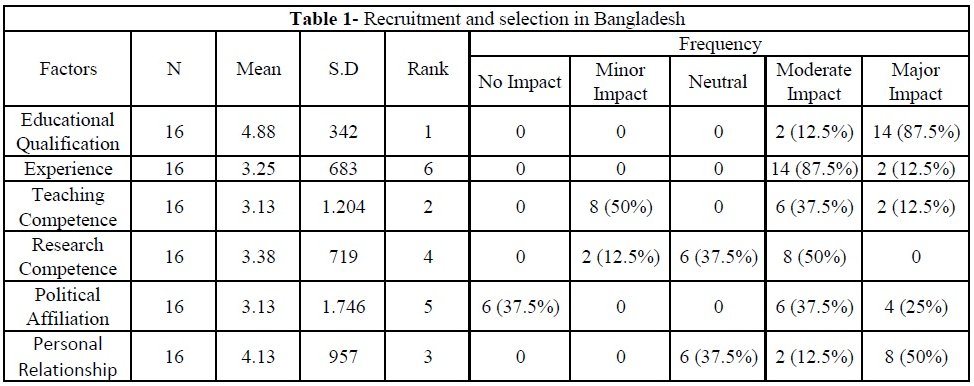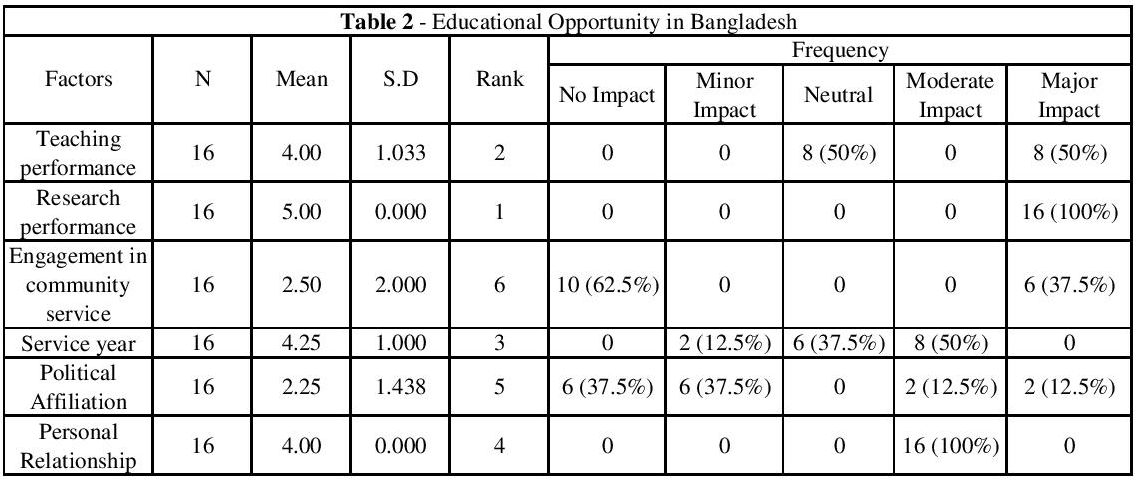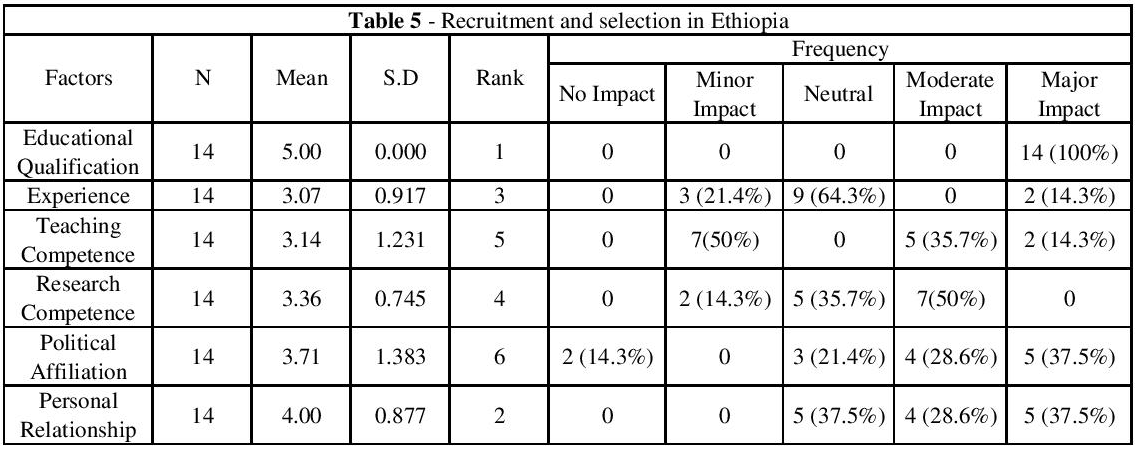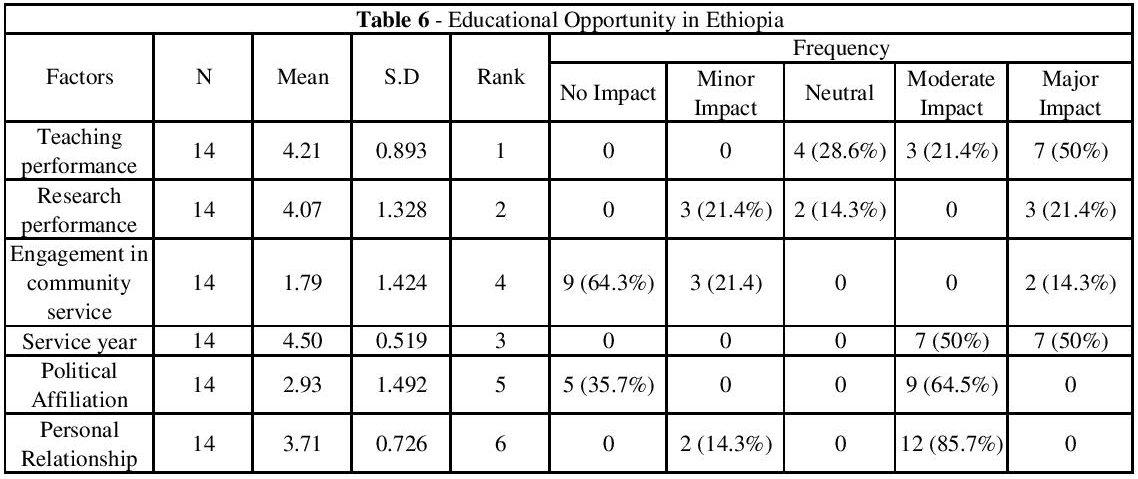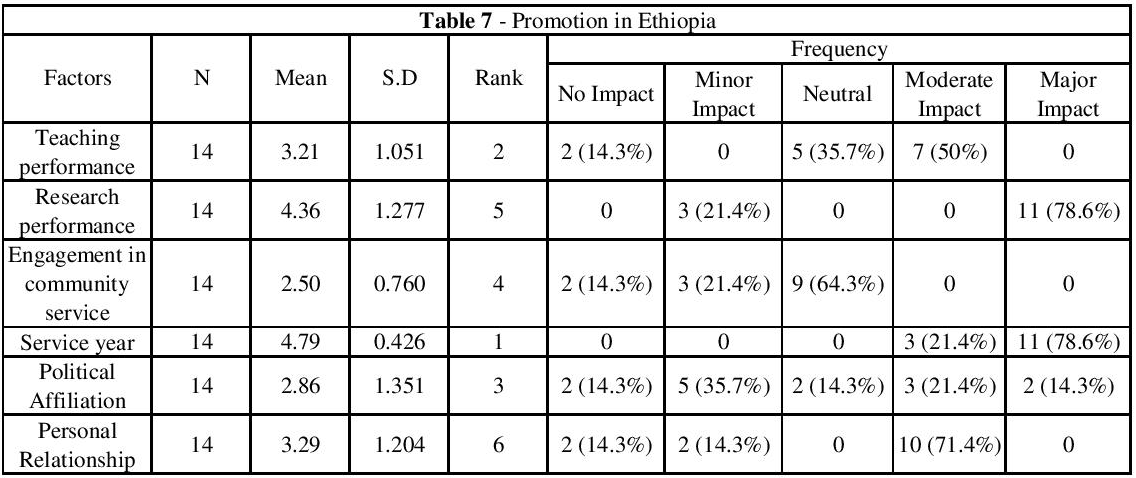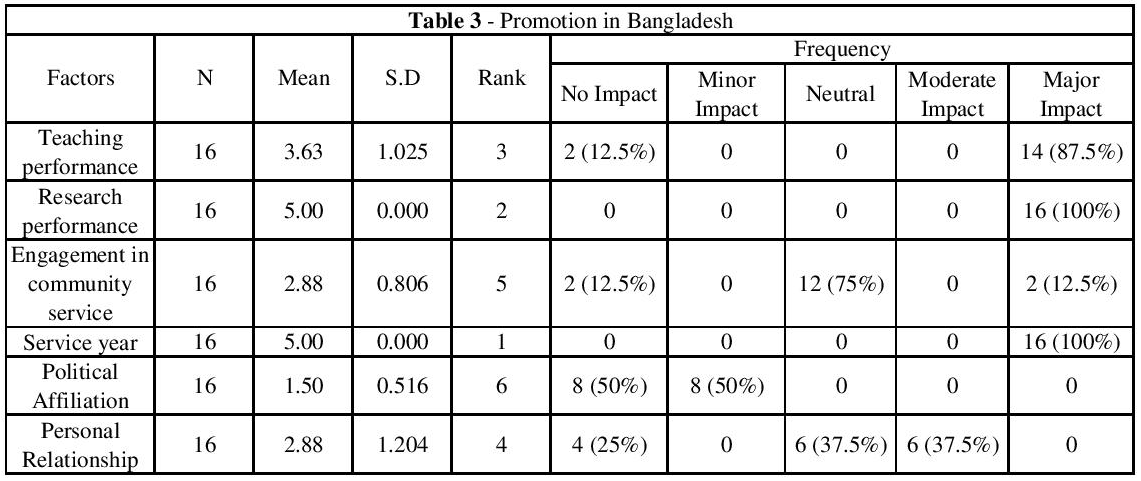Human Resource Management in Higher Education - Cases Studies and Future Scenarios
CHAPTER SEVEN
One Size Fits All? A Comparative Analysis of Developed Countries' Tenure Track Models with Developing Countries
Habtamu Diriba and Nowreen Yasmin
Introduction
Ever since the scientific inquiry of management began, there has been a hotly contested debate between two extremes. On one hand are those who believe there is one best way of doing things, which are best described as “universalists”. On the other end of the continuum are those who believe “the best” is contingent on contextual factors, hence, the key lies on finding not the best practice per se rather the “right fit” (Waiganjo & Awino, 2012; VanWart, 2015; Chênevert & Tremblay, 2011). Both schools of thought are not shy of proponents as well as critics. In this vein, it has become a norm to scrutinize every managerial strategy from these two contrasting perspectives and human resource strategy is no exception. Under the umbrella of this debate, this paper addresses the fit of the tenure track models developed by advanced nations in the context of developing countries.
To this end, an extensive review of relevant literature was made including government and Higher Education Institutions (HEIs) document. Additionally, to compensate the lack of sufficient literature on the case of developing countries and also to triangulate the misleading nature of some of the literature (as they more often than not fall under political influence and informal norms) (Abebe, 2012; Mesfin, 2012), some purposively selected academics were communicated through telephone interview and mailed questionnaire. The information from the experts was then used to complement the data collected from the literature.
This chapter is divided into four major sections. While the first section justifies the relevance of the topic under consideration, the second illustrates the basics of tenure track (TT), which is accompanied by an evaluative description of four major models in developed nations. Thirdly, the contextual realities of developing countries will be revealed before the fit of the TT model in advanced nations is scrutinized. Finally, a concluding remark is made.
Justification of the Study
Before the essay progresses any further, it sounds commonsensical to justify the relevance of the topic under consideration. To this end, three claims are made by the authors: TT model is vital, intriguing, and conceptually and practically underdeveloped.
To begin with, it goes without saying that resources are pivotal to any organization for without them the achievement of any sort of meaningful objective is inconceivable. In this regard, as most notable scholars echo time and again, it can be argued that human resources are the most valuable assets that an organization could potentially possess (Denton, et al., 2004; Gabčanová, 2011; Becker, Huselid, & Ulrich, 2001; Swathi, 2014). Such claim holds true not only in the manufacturing industry, but also to service giving entities. In this vein, it can further be asserted that, HEIs being service-giving institutions, should have a robust human resource management strategy. Central to such a strategy is a TT model that is capable of projecting career trajectories in the academic arena and ultimately determining the odds of HEIs in attracting and retaining qualified and motivated work force.
Secondly, a mere observation of TT trends in some of the largest economies of the world reveals a startling development stimulating a great scholarly curiosity. To illustrate, countries in North America, such as the U.S and Canada, are moving away from a stable and predictable TT model (Pechar, 2012). This is evidenced by the declining number of tenured positions in such countries (Jaschik, 2009; Finder, 2007; AFT Higher Education, 2009). However, countries in Central Europe, such as Germany and Austria, are loosening their traditionally highly unpredictable and rigid models and are opting for a more flexible and predictable system and in such countries, the number of tenured positions is increasing (Pechar, 2012).
Thirdly, it is possible to argue that TT is conceptually and practically underdeveloped. The theoretical underdevelopment can be justified by the dearth of research regarding TT models, especially in the context of developing countries. For example, an online review of the thematic areas published by the oldest academic journal of education in Ethiopia (The Ethiopian Journal of Education) indicated that, although some elements of TT have been analyzed with other variables, there is no consolidated research under the theme of TT. Similarly, the “key word” search of TT in some well-regarded journals from advanced nations (Journal of Research in Science Teaching, Review of Educational Research, American Educational Research Journal, and Journal of Teacher Education) reaffirms the fact that TT is understudied. Moreover, the contrasting development in different parts of the globe can serve as a true testimony of the practical contradiction surrounding the concept.
In light of such astonishing developments, this paper brings the contextual peculiarities of developing countries into the equation and tries to evaluate the fit of the major TT models formulated in the advanced part of the globe.
Tenure track: Different Trajectory under One Name
Different definitions prevail under the umbrella of TT systems (Figlio, 2013; Kaplan, 2010). As Gravestock & Greenleaf (2008, p.3) stated “tenure is a topic better illuminated by multiple spotlights than a single floodlight”. Being introduced by American Research universities in 1915 (González et al., 2012); now TT has been implemented in many advanced countries. Similarly, many developing countries have introduced some forms of TT systems in their HEIs. Traditionally “TT was regarded as a probationary period for one candidate on the way to an available, albeit not guaranteed, tenured position” (Schiewer & Jhele, 2014, p.5). The basic concept is to provide security to academics who have served a proper period of apprenticeship. Put differently, it requires adequate reason for them to be subject to exclusion from their post (Byse & Joughin, 1959). In this chapter, the TT system is conceptualized as the mechanism of recruiting faculties in HEIs permanently after completion of a substantial probationary period in the institution as a temporary employee. Probationary period is given to faculties when they first join universities. The time to tenure ranges from three to seven years based on previous professional experience and rank during appointment. However, promotion is dependent on positive evaluation and no renewed advertising and application are required (Schiewer & Jehle, 2014).
The most cited advantages of TT are: it provides academic freedom and job security to the faculties at an early stage, it strengthens faculties bonding and commitment to the respective HEI, it gives access to broad range of academic resource to support the TT appointees, it induces HEIs to maintain an extended system of evaluation to ensure quality management, it helps to attract and retain creative minds, and it ultimately improves overall performance of HEIs (Figlio, 2013; Cameron, 2010; Ehrenberg & Zhang, 2005; Walden, 1980; Schiewer & Jehle, 2014;Curtis & Jacobe, 2006).
According to a report of League of European Research Universities (LERU) four broad categories of TT system prevail in Europe and North America. Namely: the probation on the job model (UK), the two-tier promotion and habilitation model (Central Europe), the centralistic model with state approbation (France), the North America tenure-track model. The major points of departure being: year of application, terms of contract, and name and level of position (Schiewer & Jehle, 2014).
In all categories except the habilitation model, a PhD is required to join the academic pathway. However, in the habilitation model, a post doctorate degree is obligatory in order to apply for a permanent academic position. Among these four systems, acquiring tenure position is most uncertain in the habilitation model. On top of that it takes the longest time to become tenured with it taking more than seven years in some cases. A study by Kreckel (2010) showed that in 2009 almost 85% of faculties (whose main occupation was at a university in Germany) worked as dependent mid-level faculty below professor level. To sum up, the habilitation model of Germany is criticized for being rigid, time consuming, and uncertain (Pechar, 2004; Schiewer & Jehle, 2014).
The North American TT model takes about six to seven years on average (Hohm & Shore, 1998), but it has more certainty of achieving tenureship than the habilitation model. However, in the UK there is no fixed term and in France the probationary period lasts four to ten years (Kaplan 2010, Schiewer & Jhele, 2014). It is also argued that U.S. research universities provide the most prospective job offer to early stage researchers (Janger, Strauss & Campbell, 2013; Cameron, 2010). Moreover, when a tenure-track position is awarded in the American system, a mobility period for experiencing a new environment away from old networks and mentors is mandatory. At the end of this period, another evaluation – “six year up-or-out” – will be performed to decide whether the candidate is eligible for a tenured position or not (Pechar, 2012). Nonetheless, the U.S. TT system is not without its critiques in being considered as a long-term investment with risk both for the tenured and non-tenured candidates, although it should be noted that being non-tenured does not necessarily mean the end of one's academic career in. This is in sharp contrast to Europe where a negative appraisal can be career-devistating situation (Schiewer & Jhele, 2014).
In France, a centralized and state-dominated tenure system is used, which combines habilitation and probation. This system does not provide long-term commitment at a very early age (Janger, Strauss and Campbell, 2013). In this system it is comparatively easier for early career researchers to apply for permanent positions, but it undoubtedly takes time to be tenured as it follows the habilitation model for further career advancement at the university.
The tenure model of the UK provides academic freedom to permanent staffs, but now universities in the UK are limiting tenure positions by increasing fixed-term contracts, which is creating an inequality between permanent and temporary academic staffs (Kaplan, 2010; Enders & Weert, 2003).
All in all, the considerable variation among advanced countries TT system clearly indicates how pivotal contextual factors are.
Peculiarities of Developing Countries’ Higher Education System
This section presents some pertinent features of HEIs in developing countries in contrast to their counterparts in developed countries. In this vein, six major points of differences have been identified, namely: stage of HE development, Demand-Supply (DD-SS) dynamics, brain drain-gain dynamics, working condition, academic in breeding and TT dynamics.
Firstly, most developing countries are experiencing massification of their HE system, while this trend seems to have lost momentum in developed countries with a vast majority of them having realized universal tertiary education (Trow, 2002). Perhaps most of the challenges HEIs in developing countries are facing at the moment can be drawn parallel with that of advanced nations in 1980’s when similar expansion measures were undertaken. Consequently, developing countries are confronted with practical issues such as scarcity of resource and deterioration of quality (Aminuzzaman, 2007).
Secondly, DD-SS dynamics is another major point of departure between developing and developed nations. More specifically, as a result of the expansion measures described earlier, there are relatively a large number of vacant positions; however, the number of qualified professionals in the labor market seems to be in short supply (Miller et al., 2014, p. 2).The DD-SS dynamic of developed countries, on the other hand, is characterized by a completely different imbalance. In that, the relatively higher number of qualified human resource available in the labor market coupled with their capacity to attract scholars from other parts of the globe has endowed them with an abundance of trained manpower. However, the number of positions the HEIs offer are quite limited (Altbach, 2011; Cyranoski et al., 2010; Reis, 1997). Similar to the previous construct, The DD-SS dynamics has its own bearing on human resource (HR) strategies and functions such as recruitment & selection and training & development. To exemplify, according to a survey by Manpower Group (2014) who inquired the strategies of institutions in coping up with the imbalance in the labor market, “Some institutions have found it useful to appoint people who don’t currently have all of the needed technical skills, but who have the potential to learn and grow” (p.8). Such a shift in recruitment strategy in turn will clearly have an implication on training and development strategy of institutions.
Thirdly, working conditions can be compared. In this chapter, working condition is broadly operationalized to encompass not only financial, physical, and social aspects of a job, but also the political environment which may interfere with the autonomy of the academic staff. In this token, it can be argued that developed countries take the upper hand in offering better career prospects. Particularly, with a high concentration of the world’s prestigious universities, smart and ergonomic work environment that is almost free of political interference, well established network and relatively better financial package. Developed countries appear beguiling to academic profession aspirers and members (Rumbley, Pacheco, & Altbach, 2008). However, in terms of providing opportunity for training and development, developing countries offer better prospects (see Section 5).
Fourthly, brain drain-gain dynamics is a case for consideration. The term brain drain is used to describe the migration of skilled individuals who are induced by better working condition from one place to another (Comandor et al., 2004). While countries losing their qualified human resource are said to be experiencing brain drain, the host countries towards which the scholars are flowing experience brain-gain (Milio, 2012). With respect to this dimension, also there is a considerable difference, in that while most developing countries are being highly affected by brain drain; developed countries are well positioned for brain gain and this is adversely affecting developing countries (Kabir, 2012; Tekle, 2011; Rahman, 2010). As one of Bangladeshi HE experts reflected “brain drain is negatively affecting most developing countries endeavor of achieving sustainable socio economic development” and he further stressed the role of the government and universities in facilitating the return of such skilled human power to their home country.
Part of the reason can be attributed to better working conditions discussed earlier, but according to one of the experts interviewed there is more to it. He specifically mentioned the coordinated effort of advanced nations in luring skilled manpower. "Of course there is a better working condition in western countries, but the key is being conscious they are taking advantage…. They [advanced countries] are making their immigration policy very flexible, while developing countries are simply acting as spectators”.
Fifth, academic inbreeding can be used as a parameter to highlight the major difference between developing and developed countries HE system. As Horta (2012) and Hugo (2013) point out, although academic inbreeding has different conceptualization, it generally refers to a situation where academics are working in the same university they graduated from. Put differently, it concerns the lack of academic mobility. Among other things, academic inbreeding is assumed to adversely affect scientific productivity, which is at the heart of the academic profession. On this criterion also, yet again there is a considerable difference between the realities of developing and developed part of the world. In this regard, both review of the official documents as well as the opinion of the experts involved in the study indicate that academic inbreeding is more prevalent in developing countries. As a Dean from Bangladesh reflected “I believe there is a lack of awareness about the adverse impact of inbreeding. To my knowledge, there aren’t even any efforts by the university administration to address the problem”. His opposite counterpart in Ethiopia also voiced reaffirming the prevalence of academic inbreeding:
As far as I know there is no formal system in place to encourage academics to try their ability in different environments. There is also no special treatment or preference so to speak for those who have worked in other universities, in fact, to the contrary there is an inclination towards favoring our own graduates.
Lastly, there is a considerable difference in terms of TT model: A topic that will be expounded upon in the next section.
TT Systems in Developing Countries
Although both developing and developed countries exhibit considerable variation within themselves, it is however possible to identify some recognizable difference between the two regions with respect to TT. To illustrate the TT system of developing countries, two of the most senior universities in Bangladesh and Ethiopia (University of Dhaka and Addis Ababa University) have been used as a case study. Accordingly the official documents of each university along with the reflection of some the most experienced academics in each university have been considered. Based on this analysis the following features were identified.
To begin with, unlike TT systems in developed countries that require a PhD as a minimum requirement, academic careers start quite early in developing countries with a lower educational qualification. (Schiewer & Jehle, 2014; Pechar 2012, Altbach 2000), In Ethiopia, for instance, there is a possibility to embark on an academic career with only a bachelor degree as graduate assistant (Addis Abada University Senate, 2013) Similarly, it is possible to join the academic arena in Bangladesh with a master's degree (Punday & Jamil, 2010; University Grant Commission, n.d.). Furthermore as the opinion of the academics indicates personal relationship and political affiliation has an effect on the recruitment and selection process (see Table 1 & 5).
Secondly, the probationary period is usually shorter in developing countries. For instance in Bangladesh, some teachers join as permanent full-time employee and some also join as temporary full-time employees. When they will become permanent employee totally depends on the availability of vacant positions in respective departments (Dhaka University Order, 1973). Therefore, in terms of temporary full-time teachers, there is no fixed duration for the probationary period. Similarly, in Ethiopia it takes only a one year probationary period (Addis Abada University Senate, 2013). Thirdly, with respect to further progression through the academic ladder; in addition to the official criteria’s used for promotion such as service year, engagement in community service, teaching and research performance other factors come in to play. For instance, according to significant number of the Bangladesh academics involved in the study (37.5%) personal relationship has a moderate effect in the promotion of academics (see Table 3). Where as, in the case of Ethiopia, the majority of the respondents (85.7%) concurred that personal relationship and political affiliation have a role to play in an individual’s likelihood of being promoted with the latter having stronger influence (see annex in Table 7). What makes the situation more pressing in the case of Ethiopia is the fact that political affiliation ranks even higher than research performance and engagement in community service (see annex in Table 7). Similarly, in the case of Bangladesh, personal relationship matters much more than engagement in community service (see annex in Table 3).
However, according to the majority of respondents in both countries, it is not the university legislation that usually creates a problem; rather it is its implementation (see annexes in Table 4 & 8). In this regard, one Ethiopian expert, reinforces the above argument: “Although the legislation clearly states what is expected to apply for assistant, associate and full professorship, in my university it is a common trend to see academics application being delayed without any legal ground”.
Fourthly, universities take the responsibility of providing professional development opportunities in contrast to developed countries where academics shoulder the responsibility of financing their studies (at least up to PhD) (Schiewer & Jehle, 2014). In this regard one of the deans stated “As soon as our staffs satisfy the minimum requirements and become eligible for educational opportunity, the university strives to provide opportunity by collaborating with key national and international partners”.
Lastly, unlike Germanic and North American systems, TT in developing countries does not encourage mobility and hence is susceptible to academic inbreeding (Pechar, 2012).
As it stands, TT in developing countries can be applauded for its strong link with staff development as well as for its predictability. However, the loose link of performance between recruitment, selection and academic progression and also the lack of academic mobility have clear implication for quality of education.
TT Fits in Developing Countries
The first section discussed the difference between TT systems in developed countries with their relative merit and demerit. The second outlined some unique features and challenges of HE in developing countries. This section evaluates which TT system best fits with the context of developing countries. To this end, the peculiarities and challenges of HE identified in previous sections will be used as a criteria.
To start with, the UK’s probation-on-the-job model can be examined. One of the most commonly cited advantages of this model is the fact that it is relatively predictable and it offers tenure at an early career stage (Schiewer & Jhele, 2014). However the requirement of PhD as a minimum qualification makes its application practically impossible in the context of developing countries. As described earlier, these countries are affected by acute shortage of qualified workforce and also, owing to the poor working conditions, attracting such a workforce from the global market seems to be beyond their reach at the moment (Kabir, 2012; Rahman, 2010). It is hence, difficult to implement the probation model at least in its entirety. However, there are some important lessons to be drawn from UKs system. More particularly, academic freedom and merit based promotion are important mechanisms for readdressing the quality problem developing countries are battling with.
Secondly, the fit of Central Europe’s two-tier promotion and habilitation model can be checked. In this regard, it can be argued that, this the TT model with highest misfit. For one thing, its initial requirement is so high that it does not resonate well with the DD-SS dynamics described earlier. Secondly, the highly unpredictable nature of the system coupled with the lowest promotion to tenure position (Schiewer & Jehle, 2014) makes it highly unsuitable to developing countries. To elaborate, such unfavorable structures coupled with poor working conditions in developing countries only worsen brain drain problems that such countries are experiencing. What is more, it will clearly have an adverse impact on the quality of education.
Thirdly, the suitability of state approbation model in France can be evaluated. Similar to the UK’s probation model, the French system has the advantage of providing young scholars the academic autonomy and stability at an early stage. However, progression to full professorship encounters the same problem as the rehabilitation model. Hence, its initial high requirement added with its unpredictability makes it less attractive to developing countries.
Fourthly, the fit of The North American tenure-track model can be explored. Perhaps this the TT model with the highest fit. Put differently, many of its feature has a potential to address the currently, prevailing challenges of developing countries. For one, the existence of ongoing evaluation of performance and most importantly its clear link with the progression through career ladder has a key role in terms of addressing quality challenge of developing countries. Moreover, the existence of career guidance and support could significantly improve the ability of developing countries not only to attract, but also to retain qualified human power. In addition, the mandatory mobility program associated with this TT model is also invaluable in addressing the chronic problem of academic inbreeding. However, two key factors make its implementation dubious. First, as is true to all previous models, it has a high initial requirement. Secondly, the continuous evaluation and mentoring makes it resource-intensive and less practical in the context of the so often financially constrained developing countries.
Finally, before making any suggestion for the most suitable TT system, it is essential to evaluate the pros and cons of the currently prevailing TT systems in developing countries. Such evaluation would allow the identification of practices that should be retained. First and foremost, the developmental nature of the TT system is of paramount importance in addressing most of the challenges of developing nations such as the acute shortage of qualified human power, brain drain and quality deterioration and hence should be retained. Secondly, the predictability of the prevailing TT is another aspect worth retaining. Thirdly, the relatively lower requirement that would give young promising graduates a chance to embark on academic career is also another aspect worth hanging on to at least for the time being. That being said, however, prevailing problems in the system such as lack of strong links between academic progression, performance, and poor working conditions should be resolved.
Conclusion and Recommendations
In conclusion, considering the peculiarities of developing countries' HE system discussed throughout this chapter, it is practically impossible to implement any major TT system in its entirety. However, each TT system has pertinent elements that are relevant in readdressing various challenges developing countries are experiencing. Hence, a hybrid TT model that amalgamates some of the strong features of the currently prevailing TT system of developing countries with some of the pertinent and feasible features of advanced nations TT system is suggested.
Therefore, the proposed model includes: a relatively lower academic qualification (at least until the supply demand dynamics swings in favor of recruiters; however, with transparent and competitive recruitment and selection procedure). Secondly, a mandatory probationary period for retaining starting position to be justified by performance. Thirdly, similar the North American system there should be clear criteria of what is expected not only to maintain, but also to be eligible for development and promotion opportunities. Fourthly, provided a master's level minimum qualification and the ability to demonstrate the performance criteria set by the institution for a reasonable period of time (similar to UK’s model), tenure in a form of academic independence such as, the ability to be a principal investigator in a project should be granted. Fifth, similar to the North American system, continuous mentoring to help young promising academic professionals navigate through the career ladder with relative ease should be established. Lastly, opportunity for mobility should be created to enhance the flexibility, creativity and collaboration skills of would-be tenured academics.
In the long run, however, when HE expansion measures of developing countries pay off, there will be an increase in their stock of qualified academics. As a result, TT models should also evolve. During such time, a move to a more “North American” like TT system is commended. Accordingly, the requirements for entry should be raised and also a more predictable, competitive and performance based TT system should be implemented.
References
Abebe, R. (2012). Governance equalizer Ethiopia. Unpublished manuscript. Retrieved from https://www.academia.edu/5117424/Ethiopian_Higher_Education_Governance_Equalizer_Rediet_Abebe_
Addis Abada University Senate. (2013). Addis Ababa University Revised Senate Legislation. Addis Ababa University. Addis Ababa, Ethiopia. Retrieved from: http://aau.edu.et/sis/uploaded_documents/IDL1.pdf
AFT Higher Education, (2009). American academic: The state of the higher education workforce 1997-2007. Washington, D.C.: American Federation of Teachers.
Altbach, P.G. (Ed.). (2000). The changing academic workplace: comparative perspectives. Chestnut Hill MA: Centre for International Higher Education, Boston College.
Altbach, P. G. (2011). Patterns of higher education development. In: P. G. Altbach, P. J. Gumport, & R. O. Berdahl (Eds.). American Higher Education in the Twenty-First Century: Social, Political, and Economic Challenges (pp. 15-36) Baltimore, MD: John Hopkins.
Aminuzzaman, S.M. (2007). The quality issues of higher education in Bangladesh.
Byse, C. & Joughin, L. (1959). Tenure in American higher education: Plans, practices, and the law. Ithaca, NY: Cornell University Press.
Becker, B. E., Huselid, M. A., & Ulrich, D. (2001). Making HR a strategic asset. Financial Times. Retrieved from http://www.markhuselid.com/pdfs/articles/2001_Financial_Times.pdf
Cai, Y. (2012). Chinese higher education reforms and tendencies: Implications for Norwegian higher education in China. Retrieved from www.siu.no
Cameron, M. (2010). Faculty tenure in academe: The evolution, benefits and implications of an important tradition. Journal of Student Affairs, 6.
Comandor, S., Kangasniemi, M., & Winters, A. (2004). The brain drain: A review of theory and facts. Brussels Economic Review, 47 (1), 29-44.
Chait, R. (Ed). (2002). Questions of Tenure. Cambridge, MA: Harvard University Press.
Chênevert, D., & Tremblay, M. (2011). Between universality and contingency: An international study of compensation performance. International Journal of Manpower, 32(8), 856-878.
Curtis, J. W., & Jacobe, M. F. (2006). Consequences: An increasingly contingent faculty. AAUP Contingent Faculty Index. Washington, DC: American Association of University Professors.
Cyranoski, D., Gilbert, N., Ledford, H., Nayar, A., & Yahia, M. (2010). The disposable academic; why doing a PhD is often a waste of time. Retrieved from http://www.economist.com/node/17723223
Denton, R., Goldman, L., Graham, M., Reilly, C., and Twardak, M. A. (2004). Human resources your most valuable assets. International Legal Technology Association , 4-11.
Dhaka University Order, 1973. Retrieved from http://www.du.ac.bd/DownLoads/DU-15th-Statutes.pdf.
Ehrenberg, R. & Zhang, L. (2005). Do tenured and tenure-track faculty matter? The Journal of Human Resources, 40(3), 647-659.
Enders, J. & Weert, E.D. (2003). The international attractiveness of the academic workplace in Europe. Frankfurt/Main: GEW.
Figlio, D. (2013). Are tenure track professors better teachers? (NBER Working Paper No. 13-18). Retrieved from http://www.nber.org/papers/w19406.pdf
Finder, A. (2007). Decline of the tenure track raises concerns. The New York Times. Retrieved from: http://www.nytimes.com/
Gabčanová, i. (2011). The employees – the most important asset in the organizations. Human Resources Management & Ergonomics. 5(1) (2011), 30–33.
Ghafoor, M. M. (2012). Role of demographic characteristics on job satisfaction. Far East Journal. 6(1), 30-45.
González, C., Liu, Y. & Shu, X. (2012). The faculty promotion and merit system in China and the United States: The cases of Wuhan University and The University of California Davis. Retrieved from: http://cshe.berkeley.edu/
Gravestock, P. & Greenleaf, E.G. (2008). Overview of tenure and promotion policies across Canada. Toronto: University of Toronto.
Horta, H. (2012). Deepening our understanding of academic inbreeding effects on research information exchange and scientific output: New insights for academic based research. Higher Education, 65(4), 487-510.
Hugo, H. (2013). The impact of academic inbreeding on academic research – Implications for European Research Area. Retrieved from https://ces.confex.com
Hohm, C. & Shore, H. (1998). The Academy under siege: Informing the public about the merits of academic tenure. Social Perspect. 41(4), 827-832.
Janger, J., Strauss, A., & Campbell, D.F.J. (2013). Academic careers: a cross-country perspective. (Working paper No. 37). Retrieved from: http://www.foreurope.eu/fileadmin/documents/pdf/Workingpapers/WWWforEurope_W S_no0 7_MS64.pdf
Jaschik, S. (2009). The disappearing tenure-track Job. Inside Higher Ed. Retrieved from https://www.insidehighered.com/news/2009/05/12/workforce.
Kabir, A. (2012). The Politics of neoliberalism in the higher education sector in Bangladesh (Unpublished doctoral dissertation). University of Canterbury, New Zealand.
Kaplan, K. (2010). The changing face of tenure. Nature, 468,123–125
Khan, A. & Jabeen, N. (2011). Tenure track system in higher education institutions of Pakistan: Prospects and challenges. Educational Research and Reviews 6(9), 605-621.
Kreckel, R. (2010). Karrieremodelle an Universitäten im internationalen Vergleich. Retrieved from http://library.fes.de/pdf-files/studienfoerderung/07788.pdf
Manpower Group, (2014). The talent shortage continues: How the ever changing role of HR can bridge the gap. Retrieved from http://www.manpowergroup.com/wps/wcm/connect/0b882c15-38bf-41f3-8882-44c33d0e2952/2014_Talent_Shortage_WP_US2.pdf?MOD=AJPERES
Mesfin, M. (2012, March 18). Pending professorship promotions prompt protest at AAU. Addis Ababa Fortune, Retrieved from http://addisfortune.com/Vol_12_No_620_Archive/Pending%20Professorship%20Promotions%20Prompt%20Protest%20at%20AAU.htm
Milio, S. (2012). Brain drain, brain exchange and brain circulation. The case of Italy viewed from a global perspective. Rome: Aspen Institute Italia.
Miller, C., Mitchell, M. C., Kappen, J. A., & De Ocampo, M. B. (2014). Whither the professor? Crafting a viable business doctoral program in a developing country. Journal of International Business Education, 9(1), 1-18.
Pechar, H. (2004). The changing academic workplace: From civil servants to private employees. In: J. Enders & E. de Weert (Eds.). The international attractiveness of the academic workplace in Europe (pp. 32-51). Frankfurt/Main: GEW.
Pechar, H. (2012). Academic career trajectories in Europe and North America: Tenure track in decline or on the rise? 2012-2013 (CHET) Seminar Series. British Columbia: Centre for Policy Studies in Higher Education & Training.
Punday, P.K. & Jamil, I. (2010). Impact of politicization on the recruitment of university teachers in Bangladesh: The case of the University of Rajshahi.
Rahman, S. (2010). Brain-Gain in Bangladesh: What makes it. International Journal of Innovation, Management and Technology , 1 (2).
Reis, R. M. (1997). Tomorrow's Professor: Preparing for Academic Careers in science an engineering. New York, NY: IEEE Press.
Rumbley, L., Pacheco, I., & Altbach, P. (2008). International Comparison of Academic Salary, An Exploratory Study. Chestnut Hill, MA: Centre for International Higher Education, Boston College.
Schiewer, H-J. & Jehle, C. (2014). Tenure and tenure track at LERU universities: Models for attractive research careers in Europe (Advance Paper No. 17). Retreived from http://www.ub.edu/farmacia/recerca/LERU/LERU_AP17_tenure_track_final%5B1%5D.pdf
Swathi, B. (2014). A comprehensive review on human resource management practices. International Journal Of Research In Business Management , 2(9), 21-28.
Tekle, T. (2011, November 25). Ethiopia amongst worst hit in African brain-drain. Sudan Tribune. Retrieved from http://www.sudantribune.com/
Trow, M. (1970). Reflection on the transition from mass to universal Higher Education. Daedalus, 99(1), 1-42.
University Grant Commission. (n.d.). Website of Academic Council, University of Dhaka. Retrieved from http://www.ugc.gov.bd/
VanWart, M. (2015). Dynamics of Leadership in public service: Theory and practice. New York, NY: Routledge.
Waiganjo, E. W., & Awino, Z. B. (2012). Strategic human resource management and corporate performance: A critical review of the literature. DBA Africa Management Review, 2(2), 78-93.
Walden, T. (1980). Higher education: attitudes toward tenure. The Phi Delta Kappan, 62(3), 216-217.
Appendix
